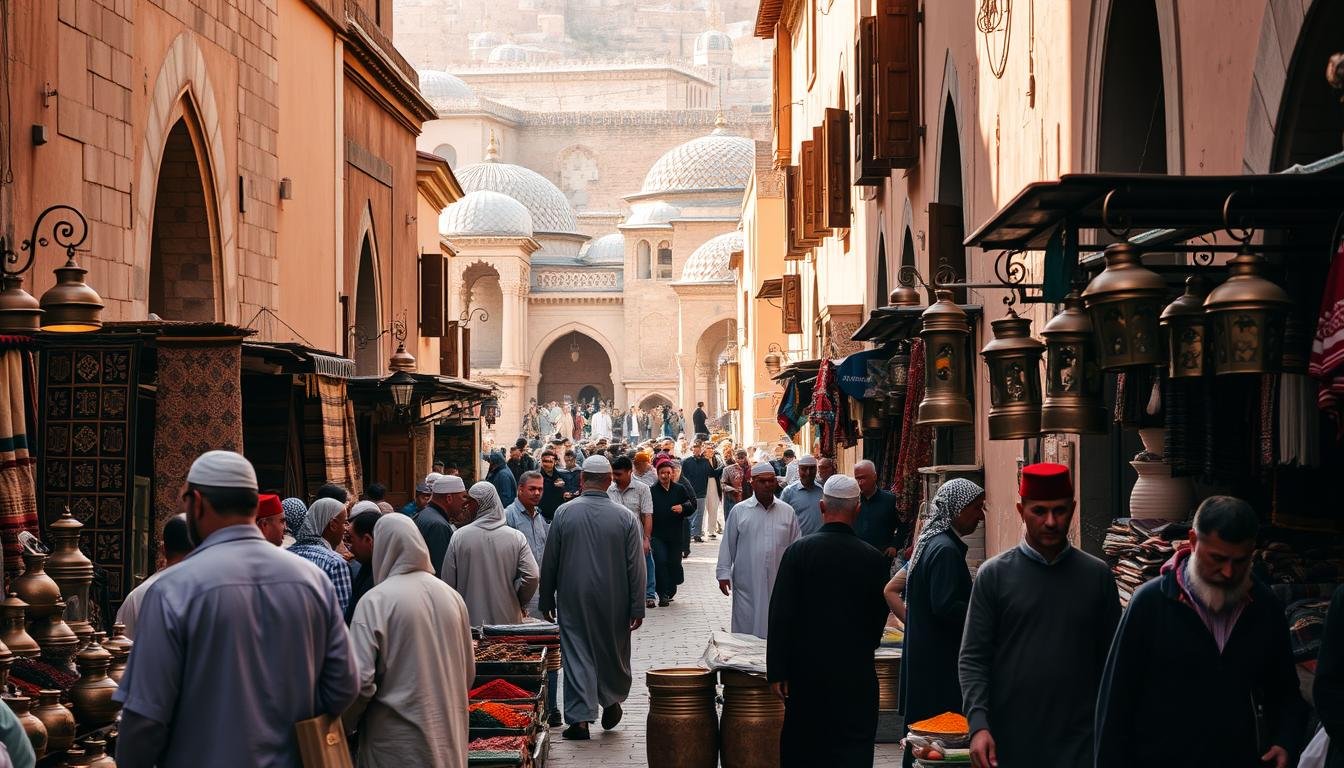Imagine a place where old traditions and lively culture meet. This is what you find in Fez, a city rich in history and culture.
Walking through Fez’s streets, you feel its deep history and vibrant culture. The sights, sounds, and smells are unlike anywhere else.
Key Takeaways
- Discover the historical significance of Fez as a cultural capital.
- Explore the city’s vibrant cultural heritage.
- Learn about the traditions that make Fez unique.
- Understand the importance of preserving cultural heritage.
- Find out what makes Fez a fascinating destination.
The Ancient Soul of Morocco
Fez is a city with a rich history, known for its ancient architecture. Walking through its narrow streets, you feel like you’ve stepped back in time. The sights, sounds, and smells of the past surround you, making it a memorable journey.
A City Frozen in Time
Fez has kept its ancient way of life alive. Its medina, a vast and well-preserved area, is a labyrinth of alleys and markets. You’ll find hidden treasures, like beautiful mosques and craftsmen at work. It’s a city that time forgot, and it’s easy to see why.
UNESCO World Heritage Status
In 1981, Fez was named a UNESCO World Heritage site. This recognition highlights its cultural and spiritual importance. It ensures that the city’s ancient beauty and traditions are preserved for future generations. The city’s preservation shows the value of cultural heritage in our world.
Historical Significance of Fez
Fez’s history is rich and has deeply influenced Moroccan culture. It is the spiritual and cultural heart of Morocco. Fez has been crucial in the country’s growth.
Foundation and Early Development
Fez was founded in the 8th century by the Idrisid dynasty. Its location made it a key spot for trade and cultural exchange. This led to a mix of cultures, making Fez a unique place.
The Golden Age of Fez
In the 13th to 14th centuries, Fez reached its peak. It became a center for learning and thought. Scholars from all over came, making Fez a beacon of knowledge.
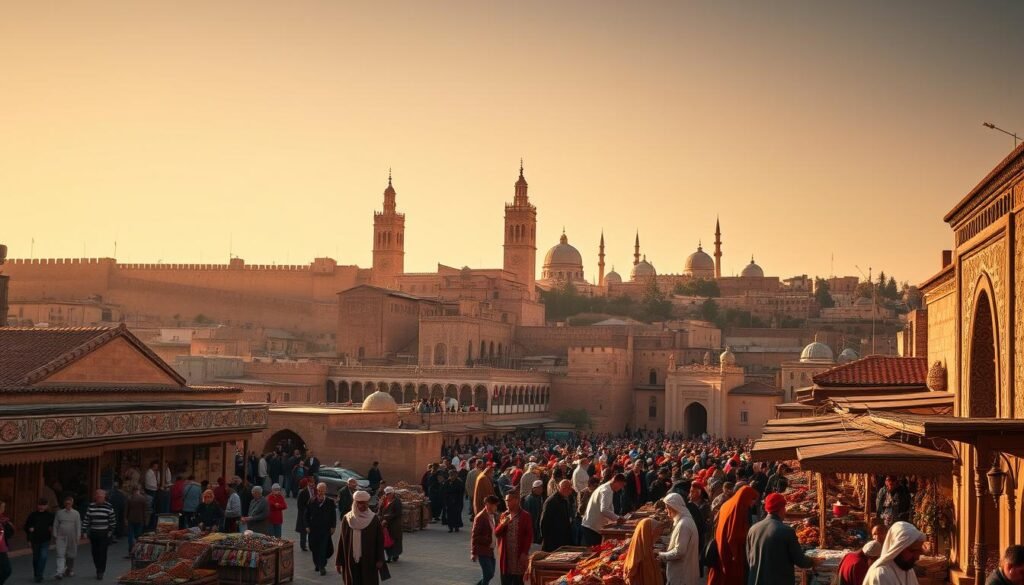
Colonial Period and Independence
The colonial era was tough for Fez, but its people kept their culture alive. After gaining freedom, Morocco aimed to revive Fez’s past glory. This celebration of history and culture continues today.
Navigating the Labyrinthine Medina
When you enter the medina of Fez, you’re thrown into a world of ancient alleys and lively markets. The medina, known as Fes el-Bali, is a goldmine of history and culture. Its car-free streets offer a unique and immersive experience for visitors.
Fes el-Bali: The World’s Largest Car-Free Urban Area
Fes el-Bali is not just any ordinary medina; it’s the world’s largest car-free urban area, covering over 280 hectares. This ancient city is a maze of narrow alleys, bustling souks, and historic landmarks. It’s a fascinating place to explore, with hidden gems like intricately tiled mosques and traditional craftsmen at work.
Tips for Exploring Without Getting Lost
To explore the medina like a local, you need a few tips. First, study a map of the medina before you start. Identify key landmarks, such as the Al-Qarawiyyin University and the Dar Batha Museum, to guide your way. You can also hire a local guide who knows the streets like the back of their hand.
| Tip | Description |
|---|---|
| Study a Map | Understand the layout of the medina to navigate effectively |
| Hire a Guide | Get insights from a local expert who knows the medina |
| Explore on Foot | Discover hidden gems by walking through the narrow alleys |
Spiritual Centers and Religious Significance
Fez is a city filled with spirituality. It has been a key place for Islamic learning for many years. Its rich religious history is seen in its many spiritual centers.
Al-Qarawiyyin: The World’s Oldest University
At the heart of Fez’s spiritual importance is Al-Qarawiyyin University. It is the oldest university still in operation. Founded in 859 AD, it has been a center for Islamic learning and scholarship.
Al-Qarawiyyin’s historical value is huge. It has greatly influenced Islamic thought and education.
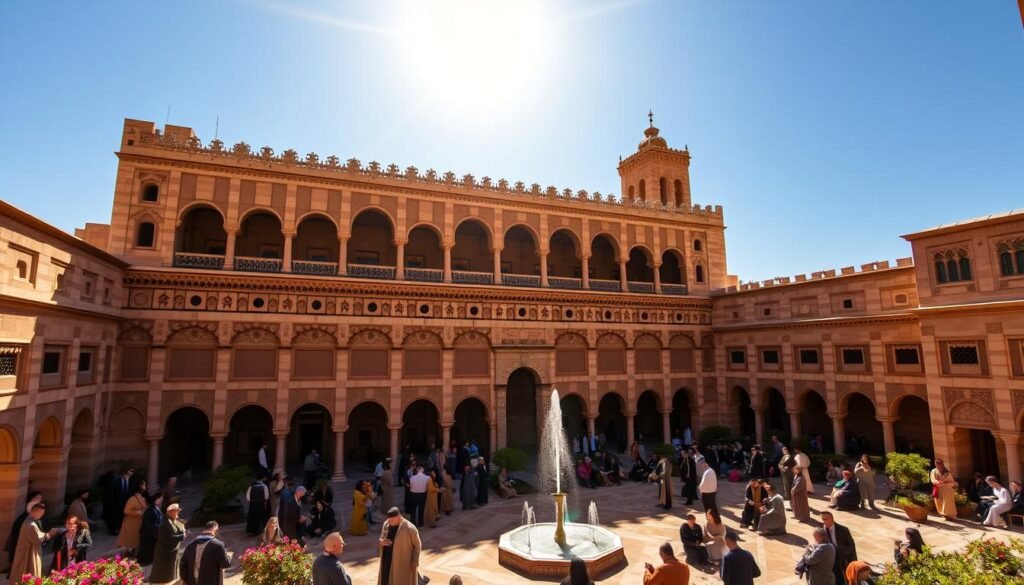
Mosques and Madrasas
Fez has many mosques and madrasas, each with its own style and history. These places are not just for worship. They are also centers of learning and community.
The beautiful tile work and craftsmanship show Fez’s rich cultural heritage.
Fez as a Center of Islamic Learning
Fez’s role as a center for Islamic learning comes from its history and places like Al-Qarawiyyin. For centuries, it has drawn people seeking knowledge in Islamic studies and more. This legacy still shapes the city’s culture and identity.
The Traditional Fez Hat: A Symbol of Cultural Identity
The Fez hat is a key part of Moroccan heritage, with a history that goes back centuries. It’s more than just a hat; it’s a symbol of Moroccan culture. It holds deep meaning beyond being a fashion statement.
Origins and Historical Significance
The Fez hat comes from the city of Fez, dating back to the 8th century. Its name is tied to the city. It was once a sign of status and knowledge, especially among the educated.
It was also adopted by the Ottoman Empire. This made it even more important in the region’s culture.
Craftsmanship and Production
Making a traditional Fez hat is a detailed process that needs a lot of skill. Artisans use top-quality felt, usually from wool, to create the hat’s unique shape. The hat goes through many steps, like shaping, dyeing, and adding designs.
Where to Buy an Authentic Fez in the City
Looking for a real Fez hat? The medina of Fez has many souks with high-quality, handmade hats. Look for well-known artisans in traditional souks. You can also check out markets like the Souk el Attarine, famous for its crafts, including Fez hats.
Make sure to buy from a trusted source for authenticity. A real, handmade Fez hat is a great souvenir. It connects you to Fez’s rich cultural heritage.
Artisanal Treasures of Fez
Walking through Fez’s ancient streets, you’ll find a treasure trove of artisanal wonders. For ages, Fez has been known for its talented artisans. They’ve mastered the art of traditional crafts.
The Tanneries: A Sensory Experience
The tanneries in Fez are a must-see. They offer a unique sensory journey. You’ll see artisans working, surrounded by colorful hides and strong smells. It’s a great spot to find a unique Moroccan Fez hat.
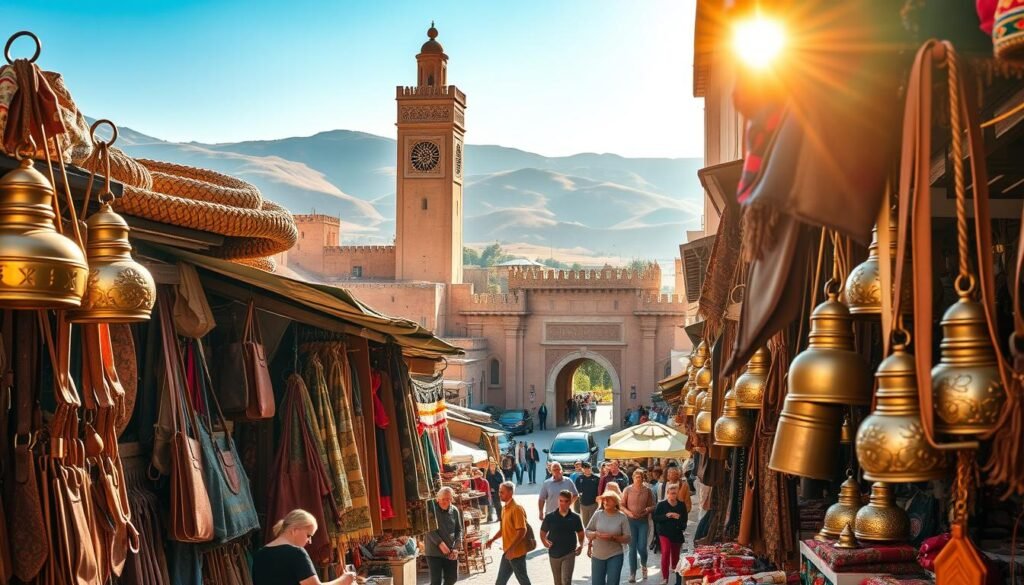
Pottery, Ceramics, and Zellige
Fez is known for its stunning pottery, ceramics, and zellige (handmade tiles). You can visit souks and workshops to see artisans creating beautiful designs. Look out for:
- Hand-painted ceramics
- Intricately designed zellige tiles
- Beautifully crafted pottery
Metalwork and Woodcarving
Fez is also famous for its metalwork and woodcarvings. You can find unique items like lanterns and decorative boxes. These make great souvenirs. Check out the souks and markets in the city for authentic Fez for sale.
Culinary Delights of Fez
As you explore Fez’s ancient medina, you’ll be greeted by the enticing smells of Moroccan food. The city’s food reflects its rich culture, with dishes that will excite your taste buds.
Traditional Fassi Cuisine
Fassi cuisine is famous for its complex flavors and scents. It often includes preserved lemons, olives, and spices. Fassi dishes are slow-cooked, blending flavors into a rich experience. They focus on local and seasonal ingredients, making meals both delicious and true to the culture.
Must-Try Dishes and Where to Find Them
Fez’s food scene is full of must-try dishes. B’stilla, a pie with flaky pastry, meat, onions, and spices, is a must-try. You can find great B’stilla at Dar Roumana. Don’t miss Tagine, a slow-cooked stew, at medina restaurants.
| Dish | Description | Recommended Location |
|---|---|---|
| B’stilla | Savory pie with layers of flaky pastry, meat, onions, and spices | Dar Roumana |
| Tagine | Slow-cooked stew cooked in an earthenware pot | Restaurants in the Medina |
| Khobz | Traditional Moroccan bread | Local Bakeries |
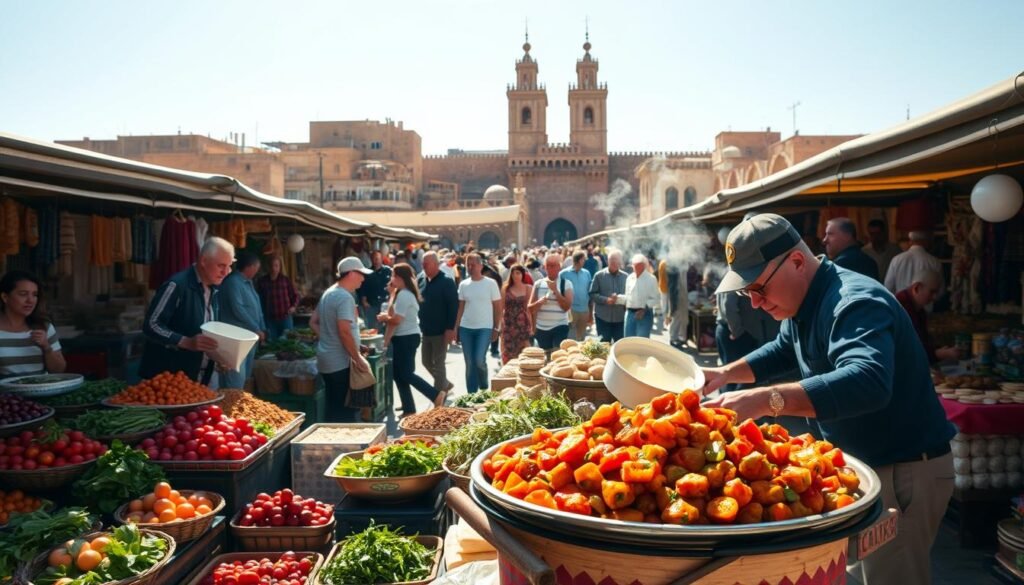
Fez’s food scene is a deep dive into the city’s culture and history. Exploring local cuisine, you’ll find each dish has its own story of tradition and heritage.
Festivals and Cultural Events
Fez is a city that loves to celebrate. It hosts many festivals and cultural events all year round. These events show off the city’s rich culture and let you feel the lively spirit of Fez.
Fez Festival of World Sacred Music
The Fez Festival of World Sacred Music is a big deal in Fez. Musicians and performers from all over the world come together. They celebrate music as a universal language.
The festival has a wide range of music. You’ll hear everything from traditional Moroccan tunes to modern songs. It all focuses on sacred music.
Other Cultural Celebrations
Fez also has other cultural events besides the music festival. There are traditional festivals, cultural shows, and religious events. These give you a peek into the city’s deep heritage.
Visitors can dive into the local culture by joining these events. You’ll see traditional music, dance, and taste local foods.
If you want to remember Fez, you can Buy Fez online. It’s a symbol of the city’s cultural identity.
Modern Fez: Balancing Tradition and Progress
Exploring Fez today shows a city trying to keep its rich past alive while moving forward. Its old buildings and deep history make it special. Yet, these also make it hard to grow and change.
Economic Challenges and Opportunities
Fez struggles with high joblessness and depends a lot on old trades like textiles and crafts. But, the city sees chances for growth with tourism and foreign money. Plans to make the economy more diverse and support new businesses are underway. They aim to bring in more jobs and help local shops thrive.
Preservation Efforts and Urban Development
Keeping Fez’s cultural treasures safe is a big goal. Restoration work is ongoing to keep the city’s old buildings and landmarks in good shape. At the same time, there are plans to upgrade the city’s infrastructure, like roads and public services. The big challenge is finding a way to modernize without losing what makes Fez unique.
| Initiative | Description | Impact |
|---|---|---|
| Economic Diversification | Promoting entrepreneurship and new industries | Job creation and economic growth |
| Restoration Projects | Maintaining historic architecture and monuments | Preservation of cultural heritage |
| Urban Development | Improving infrastructure and public services | Enhanced quality of life for residents |
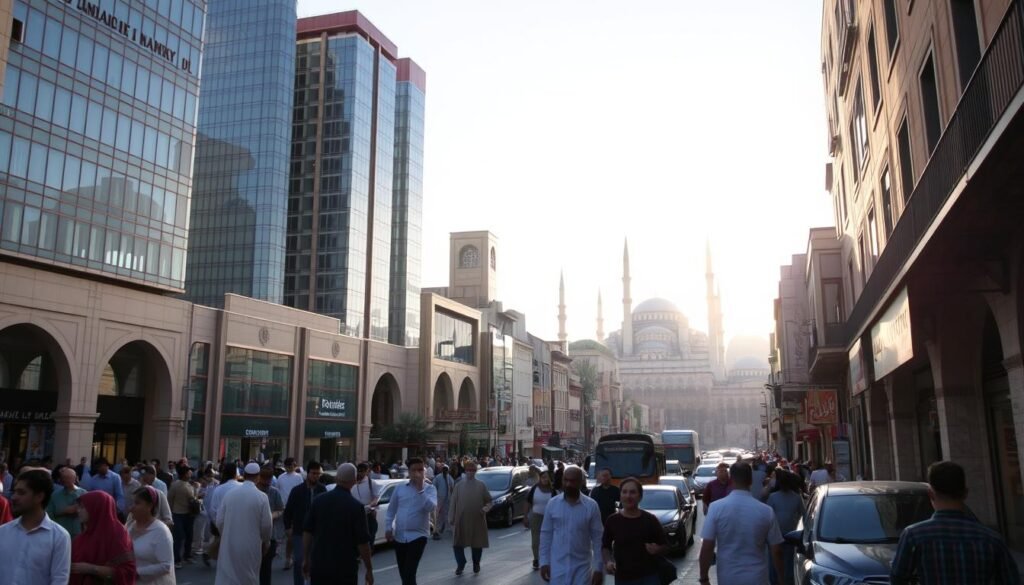
Planning Your Visit to Fez
To fully enjoy Fez’s rich heritage, plan your visit well. Consider the season, where to stay, and cultural norms. Fez is a key cultural and spiritual center, so it’s important to approach it with care.
Best Times to Visit
The best times to visit Fez are spring (March to May) and autumn (September to November). The weather is mild and nice during these periods. It’s perfect for exploring the ancient medina and its surroundings without the summer heat or winter cold.
Accommodation Options
Fez has many places to stay, from traditional riads to modern hotels. You can choose to stay in the medina for a real experience or newer hotels outside for more comforts. A riad stay offers a unique, culturally rich experience.
Cultural Etiquette for Visitors
Respecting local customs is key when visiting Fez. Dress modestly, especially in mosques or private homes. Also, remove your shoes before entering some buildings as a sign of respect. Learning basic Arabic phrases can improve your interactions with locals.
Conclusion: The Enduring Legacy of Fez
As you finish your trip to Fez, you’ll remember its rich culture and history. The city shows how to keep traditions alive while moving forward. The famous Fez hat is a big part of its cultural identity.
Fez is full of experiences, like wandering the Medina or finding spiritual and artisanal treasures. It’s a place for history buffs, culture lovers, and anyone looking for a new adventure. Your visit to Fez will leave you with unforgettable memories and a desire to come back.

